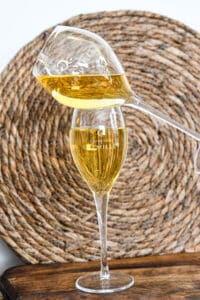
COMPOSITION OF CHAMPAGNE – OENOLOGICAL PARTICULARITIES
When discussing the composition of Champagne, one inevitably thinks of the three grape varieties that account for 99% of production: Pinot Noir, Meunier, and Chardonnay.
The sugar dosage in Champagne determines its typicity. Maison Gremillet invites you to learn more about the famous liqueur known as dosage or expedition liqueur…
SUMMARY

What Sugar Dosages Are Used in Champagne?
Champagne labels necessarily indicate one of the following mentions: Brut, Extra Brut, Sec… This corresponds to the sugar dosage present in the Champagne. Defined by the strict Champagne specifications, the sugar content in Champagne is indeed one of the mandatory mentions on the label. It is, in a way, the first key to reading a label because it tells us what type of Champagne we are dealing with. This step of adding the dosage liqueur takes place during disgorgement, the final stage of the winemaking process, which is absolutely crucial for the wine’s balance. Generally, the longer a wine has aged in the bottle, the less it will need to be dosed. The concentration of the liqueur varies from more to less sweet according to the classification below:
There are also the mentions Brut Nature or Dosage Zéro, which exclude the addition of liqueur but whose analyses will indicate a sweetness below 3 grams per liter (these are the residual and natural sugars from the grape). There has been a real trend over the past few years for this type of pure Champagne. Within our collection, the cuvée named Zéro Dosage will perfectly meet this demand.
Sugar and Dosage: The House Secret
The composition of the dosage liqueur is unique to each Champagne house. Some will use reserve wines carefully stored in vats, casks, or sometimes in demijohns. Others will resort to MCR (rectified concentrated must), a rather unappealing term that refers to a ready-made solution purchased from a supplier. At Maison Gremillet, the recipe is homemade and carefully concocted by Jean-Christophe Gremillet, the cellar master, by blending cane sugar with wines that have been re-circulated (in other words, bottles that are ready to drink, uncorked, and reintroduced into the circuit). This method is quite rare in Champagne; it is rooted in our history, and we are committed to preserving it. In fact, the early days of the house focused on land acquisition and obtaining new vineyards. Thus, for the first 20 years, a significant portion of the winemaking process (read our article on the Champagne method) was outsourced, and no reserve wines were stored. Our juices were returned to us in bottles, and to create our dosage liqueur, we necessarily had to open and re-circulate some of these bottles. We have kept this method because it has the great advantage of marrying our wines with our own wines, thus avoiding any external additions.
Sugar and Dosage: The Choices of Maison Gremillet
Increasingly seeking transparency, consumers like to know the details of how a Champagne is made. The winemaker will always enjoy telling them the story of each wine created for them, but this quest for information should not detract from the pleasure of the palate. Our suggestion is to taste first, let yourself be carried away by the sensations and the journey that each wine offers before delving into its creation. Too often, the opposite approach already creates preconceptions, which is a real shame. In wine, everything is about balance. The same dosage on one cuvée or another can be perceived very differently depending on the base wine it blends with. Generally, we maintain an average dosage of around 9 grams of sugar per liter because we want our Champagnes to be easy to drink and appreciated by the widest audience. Of course, our Extra Brut and Brut Nature will meet the preferences of purists, but these dosages cannot be generalized across the entire range. They require an experienced palate and specific food and wine pairings.


When discussing the composition of Champagne, one inevitably thinks of the three grape varieties that account for 99% of production: Pinot Noir, Meunier, and Chardonnay.

For many decades, the production of Champagne has followed a precise and well-established process. The making of Champagne respects traditions and practices, which Maison Gremillet

Understanding the Difference Between Non-Vintage Brut Champagne and Vintage Champagne. The world of Champagne is vast and varied, offering a multitude of choices for wine